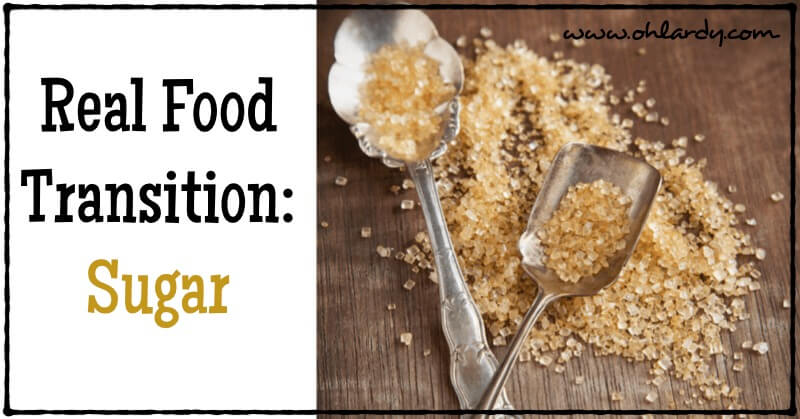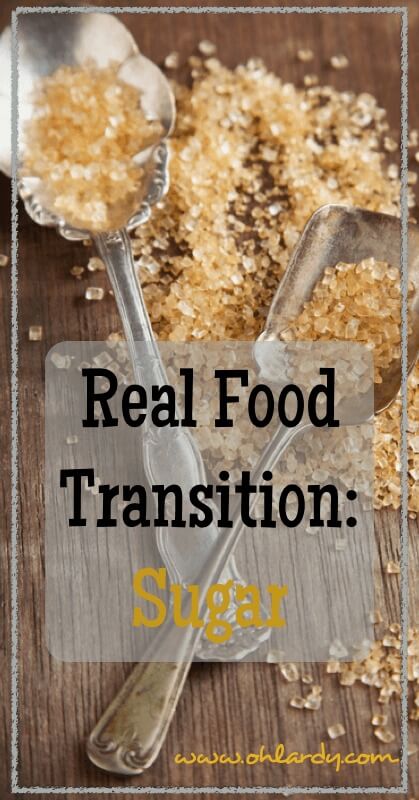Real Food Transition: Sugar
Oh Lardy! is a participant in the Amazon Services LLC Associates Program, an affiliate advertising program designed to provide a means for us to earn fees by linking to Amazon.com and affiliated sites.

When you are making the switch to Real Food, there are many ingredients that will need to be swapped out in your kitchen. It can all be very confusing, but I find taking things one step at a time helps tremendously.
I've previously written my 10 Tips for starting on Real Food. Kelly's has given her story how she just dove right in and Oh Lardy has a comprehensive Getting Started with Real Food page. I've written about the importance of changing the salt you use in your kitchen.
Now let's talk about changing out your sugars and sweeteners.
Most people have white sugar, brown sugar and possibly honey or maple syrup (hopefully the real stuff, not the high fructose corn syrup, maple flavored garbage).
Hopefully you do not have any artificial sweeteners in your house anymore! Artificial sweeteners, such as sweet-n-low, equal, truvia, splenda should not be in a Real Food kitchen. These are not good for your body…period. The dangers of artificial sweeteners could be a whole other blog post. For now…read here, here, here and here.
Regular white and brown sugars are highly processed and are completely stripped of their nutrients. And, if the package does not say ‘cane sugar', it is most likely sugar made from GMO sugar beets…yuck!
In the Real Food kitchen, the sugar needs to be changed up! You need to find healthy sugar alternatives! I like to be sure that the ingredients I use in my home (even sugar) have lots of nutrients; that they are not overly processed where these nutrients have been removed. There are many great natural sweeteners that have a place in the Real Food kitchen.
I do want to warn you, however, these are still sugars and should be used in moderation. Too much sugar, no matter how natural it is, is not good for your body!
Here are the natural sugars that make a regular appearance in my pantry:
Raw Honey (local preferably)
Honey is a great sweetener to use in many different dishes, drinks, smoothies, granola. According to Nourishing Traditions, raw honey is full of enzymes that help digest carbohydrates and has all of the nutrients found in plant pollens. Honey is also anti-bacterial, anti-fungal and anti-viral. (Children under 1 should avoid honey).
Maple Syrup
Real maple syrup is rich in minerals, including manganese and zinc. Be sure your maple syrup is the real deal and not high fructose corn syrup with maple flavoring. Grade B maple syrup is said to be more nutrient rich than Grade A. However, I buy what I can and what my budget allows.
Coconut Sugar
Coconut or palm sugar is sugar made from the nectar of the palm tree flower. It is very low glycemic and is mildly sweet. I use granulated coconut sugar often in baking.
Rapadura and Sucanat
Rapadura and Sucanant are simply dehydrated cane sugar juice. They are very high in minerals and works great in baking recipes. They both have a mild molasses flavor. I tend to use rapadura often for a variety of uses. I buy it in bulk but have seen both products at local grocery stores.
Date Sugar
Date sugar is made from dehydrated dates. It does not dissolve well so has limited uses. It is very high in fiber and vitamins and minerals. It also contains tryptophan, which can have a calming effect, especially on children. I have sprinkled it on oatmeals and on top of sweet potatoes. It is tasty without being too sweet.
Molasses
Molasses is the by-product of the processing of white sugar. It is very high in minerals including iron, calcium, zinc, copper and chromium. It has a strong flavor. I like to use it in baking or to add to oatmeal or smoothies.
Stevia
Stevia is an herb that is popular in South America. It is hundreds of times sweeter than sugar but has no calories. I grow stevia in my herb garden. There's some controversy over which types of stevia products to buy at the store and whether or not they are ‘real food' acceptable but according to Nourishing Traditions, green stevia powder is the recommended one. I have even dehydrated the stevia from my garden and grind it up into a powder. I also like liquid stevia extracts that are just stevia and alcohol or stevia and water. I have thought about making my own extract after discovering this tutorial. Maybe next summer!
Malted Grain or Sorghum Syrups
These syrups are made with either malted grains (usually barley) or sorghum. They can be used in place of maple syrup. I have never used these types of sweeteners so can't comment on their uses or tastes.
Now, go to your pantry and see what you can switch out this year. Every time you shop try to add more and more real and nourishing ingredients to your pantry and soon you will have a Real Food Kitchen!!
Wondering where to buy these sweeteners? Whole Foods, Trader Joes and other natural grocery stores carry many of these. Health food stores also are a good resource. Many are readily available in your regular grocery stores if you look carefully.
Are you looking for more sweetener options? This post from LA Healthy Living has some great healthy sugar alternatives.
What real sweeteners are your favorites and how do you use them?
PIN IT–>
Sources:
http://www.whfoods.com/genpage.php?tname=foodspice&dbid=115
http://www.whfoods.com/genpage.php?tname=foodspice&dbid=96
http://www.organiclifestylemagazine.com/healthy-sugar-alternatives/
www.westonaprice.com
Weston A Price Natural Sweeteners
This post is featured at: Simple Lives Thursday, Thank Your Body Thursday, Tasty Traditions, Fight Back Friday, Fresh Bites Friday, Sunday School Blog Carnival, Make Your Own Monday, Thank Goodness it's Monday, Fat Tuesday, Scratch Cooking Tuesday, Slightly Indulgent Tuesday, Family Table Tuesday, Party Wave Wednesday


Which would you suggest as a substitute for brown sugar? I am not a fan of molasses, but am willing to try something 🙂
I use rapadura and it works just fine. You do lose the moisture that comes with the brown sugar but I have not had a problem for cookies, etc. Coconut or palm sugar would work well too but would be less sweet.
I’m glad you posted this! I’ve been confused about the best substitutes to use in baking for regular white sugar. I used Turbinado cane sugar from trader Joe’s in some of my baking over the holidays & didn’t get great results. Is that more of a brown sugar subsitute?
Thanks, Jodi!
Turbinado is a processed sugar where most of the molasses has been removed (and most of the nutrients are gone). While definitely a better choice over refined white sugar or brown sugar…I would try rapadura, sucanat or coconut sugar in its place for even less processed. Sometimes you can sub honey or maple syrup for white sugar but not on a 1-1 basis. You can try something like 3/4 cup honey for every 1 cup white sugar. In the end, however, it is all still sugar 😉
http://www.thehealthyhomeeconomist.com/sugar-in-the-raw-thats-not/
http://nourishedkitchen.com/a-guide-to-natural-sweeteners-how-to-use-them/
I love that you included sorghum syrups! 🙂
Thanks so much for sharing this in this week’s Thank Goodness It’s Monday carnival.
Blessings!
Kresha from NourishingJoy.com
Thank you for your submission on Nourishing Treasures’ Make Your Own! Monday link-up.
Check back tomorrow when the new link-up is running to see if you were one of the featured posts! 🙂
Thank you thank you! I was JUST thinking about this yesterday and happened to find this post via Nourishing Joy. We are working on this slowly but surely.
So glad you found us!!! Good luck with your real food journey!!
Do you know anything about Swerve as a replacement for white sugar? I think I read it can be used 1-1.
Thanks! Great info!
I don’t know anything about Swerve. Maybe another reader can comment!
Any thoughts on raw cane sugar?
Do you know anything about monk fruit? I’m looking for a healthy real food substitute to continue on my Weights Watchers journey. I’m trying to stay away from artificial and processed foods. Thanks!
I really don’t! I have heard of it but am not knowledgable!